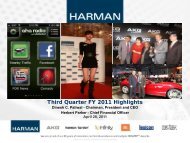You also want an ePaper? Increase the reach of your titles
YUMPU automatically turns print PDFs into web optimized ePapers that Google loves.
<strong>Harman</strong> International Industries, Incorporated and Subsidiaries<br />
(Dollars in thousands, except per-share data and unless otherwise indicated)<br />
For each derivative instrument that is designated and qualifies as a fair value hedge, the gain or loss on the<br />
derivative instrument as well as the offsetting loss or gain on the hedged item attributable to the hedged risk are<br />
recognized in current earnings during the period of the change in fair values. For each derivative instrument that<br />
is designated and qualifies as a cash flow hedge, the effective portion of the gain or loss on the derivative<br />
instrument is reported as a component of other comprehensive income and reclassified into earnings in the period<br />
during which the hedged transaction affects earnings. For derivative instruments not designated as hedging<br />
instruments, the gain or loss is recognized in current earnings within cost of sales during the period of change.<br />
Refer to Note 7 – Derivatives for additional information.<br />
Interest Rate Management: We have an interest rate swap agreement to effectively convert the interest on<br />
an operating lease from a variable to a fixed rate. At the end of each reporting period, the discounted fair value of<br />
the interest rate swap agreement is calculated. The fair value is recorded as an asset or liability. The effective<br />
gain or loss is recorded as a debit or credit to accumulated other comprehensive income and any ineffectiveness<br />
is recorded immediately to rent expense. Upon maturity, any gain or loss within AOCI is reclassified into<br />
earnings in the then-current period. Refer to Note 7 – Derivatives for additional information.<br />
Foreign Currency Management: The fair value of foreign currency related derivatives is included in the<br />
Consolidated Balance Sheets in other current assets and accrued liabilities. The earnings impact of cash flow<br />
hedges relating to forecasted purchases of inventory is reported in cost of sales to match the underlying<br />
transaction being hedged. Unrealized gains and losses on these instruments are deferred in other comprehensive<br />
income until the underlying transaction is recognized in earnings. The earnings impact of cash flow hedges<br />
relating to the variability in cash flows associated with foreign currency denominated assets and liabilities is<br />
reported in cost of sales or other expense depending on the nature of the assets or liabilities being hedged. The<br />
amounts deferred in other comprehensive income associated with these instruments relate to spot-to-spot<br />
differentials from the date of designation until the hedged transaction takes place.<br />
Severance and Exit Costs: We recognize liabilities for severance and exit costs based upon the nature of<br />
the liability incurred. For involuntary separation programs that are conducted according to the guidelines of our<br />
written involuntary separation plan, we record the liability when it is probable and reasonably estimable in<br />
accordance with Statement of Financial Accounting Standard (“SFAS”) No. 112, “Employers’ Accounting for<br />
Postemployment Benefits.” For involuntary separation programs that are conducted according to the provisions of<br />
collective bargaining agreements or statutes, we record the liability when it is probable and reasonably estimable<br />
in accordance with SFAS No. 88, “Employers’ Accounting for Settlements and Curtailments of Defined Benefit<br />
Pension Plans and for Termination Benefits.” For one-time termination benefits, such as additional severance<br />
pay, and other exit costs, such as lease and other contract termination costs, the liability is measured and<br />
originally recognized at fair value in the period in which the liability is incurred, with subsequent changes<br />
recognized in the period of change, in accordance with SFAS No. 146, “Accounting for Costs Associated with<br />
Exit or Disposal Activities.” Refer to Note 12 – Restructuring for more information.<br />
Share-Based Compensation: Effective July 1, 2005, we adopted SFAS No. 123R, Share-Based Payment<br />
(“SFAS 123R”), using the modified prospective method. Under SFAS 123R, share-based compensation expense<br />
is recognized based on the estimated fair value of stock options and similar equity instruments awarded to<br />
employees. Refer to Note 11 – Shareholders’ Equity and Share-Based Compensation for additional information.<br />
56





